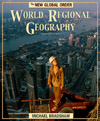Use this outline to increase
your understanding of the important characteristics of Eastern Asia.
- From Periphery to Core
-- Although economic growth has slowed recently, progress has been substantial
among the variety of countries in this region.
- Internal and External
Cultural Influences -- Chinese culture and colonialism are the two most important
influences.
A. Chinese Empires --
A great civilization ruled by a series of dynasties developed around the major
rivers of China. Confucianism, Taoism, and Buddhism were religious influences.
B. Other Kingdoms -- Japanese,
Mongolian, Vietnamese, Korean, and other kingdoms developed around China.
C. European Intrusions
-- Colonial trade, missionaries, and military power affected the kingdoms
of Eastern Asia to a greater or lesser extent. Hong Kong becomes a British
possession.
- Natural Environment --
Millions of people are crowded into lowland areas.
A. Tropical and Midlatitude
Climates -- The major climatic types varying according to latitude.
B. Mountains and Islands
-- Eastern Asia is quite mountainous overall with plate tectonics causing
the formation of many islands.
C. Major Rivers -- The
lower parts of the rivers have lowlands and deltas.
D. Tropical Rainforest
to Midlatitude Desert -- Vegetation patterns follow climatic patterns.
E. Natural Resources --
Fertile soils and valuable minerals are important. International cooperation
is needed to manage the Mekong River.
F. Country Boundaries
-- Several boundary disputes increase tensions in the region.
G. Environmental Problems
-- Plate movements cause earthquakes and volcanic activity. Heavy rains frequently
lead to flooding. Deforestation, desertification, disease, and pollution are
major concerns made worse by the large population.
- Japan, South Korea, and
Taiwan -- Economic successes make Japan one of the richest countries in the
world. With help from the United States, South Korea and Taiwan have enjoyed
rapid economic growth.
A. Countries -- South
Korea and Taiwan are much smaller in land area and population than Japan.
Each of Japan's four major islands differ in natural environment, urbanization,
and manufacturing.
B. People -- All three
countries are densely populated and have little cultural diversity. Japan
has the world's lowest infant mortality and the longest life expectancy. The
populations live mostly in cities.
C. Economic Development
-- In Japan, there were many changes after World War II with agriculture becoming
less important, manufacturing being rebuilt without an emphasis on military
products, and profits being spent on consumer goods and invested in overseas
projects. The South Korean economy was transformed from subsistence farming
to industrial giant. South Korea's recent debt problems are not shared by
Taiwan which has a large trade surplus.
- China, Mongolia, and
North Korea -- Normally a great power, China is recovering some of its influence
under Communist leadership. The Great Leap Forward and the Cultural Revolution
were important periods. Mongolia is a buffer state, North Korea is Communist,
and both are isolated.
A. Countries -- The regions
of China vary from north to south and from lowlands to mountains. Mongolia
is landlocked and sparsely populated, whereas North Korea and its numerous
problems remain apart from the world economy.
B. People -- In China,
population growth was slowed in order to allow standards of living to be improved.
Economically significant communities of Chinese people are found outside of
China.
C. Economic Development
-- The centrally controlled economy emphasized manufacturing even though the
more people worked in agriculture. Communes give way to the household responsibility
system. Foreign investment and expertise contribute to continuing economic
development. China is very strong in coal and hydroelectricity. Part of China
since 1997, Hong Kong's trade, financial services, and manufacturing are significant
additions to China. Central control of the economy is also important in Mongolia
and North Korea.
- World Issue: Population
Policies -- Thailand and China have implemented successful population control
programs, whereas Indonesia has changed the distribution of some of its population.
- Southeastern Asia --
Consistent with the numerous islands and long coastlines, this subregion has
been influenced by China, Japan, and other external forces.
A. Countries -- Brunei
and Singapore are wealthy in contrast to the poverty of Cambodia and Laos.
ASEAN was established initially as a military alliance against the threat
of communism, but Laos, Myanmar, and Vietnam are members now.
B. People -- Population
growth rates have fallen in most places. The region contains much ethnic and
religious diversity.
C. Economic Development
-- The non-communist countries have experienced rapid industrialization. The
Green Revolution has helped rice production and subsistence farming has been
replaced by commercial farming in many areas. Governments encourage foreign
investment. The financial crisis of the late 1990s has created economic and
political instability.
- Living in Malaysia --
Malaysia is characterized by growing prosperity, more consumer goods, democracy,
and diverse ethnicity. Environmental concerns are increasing.
- Landscapes include traditional
features like Buddhist temples and rice paddies and modern features like apartment
blocks and new roads.
- Future Prospects -- For
a variety of reasons, Eastern Asia has grown quickly in economic and political
power. It has a lot of potential to continue its growth in the coming decades,
but much infrastructure is needed and conflicts could break out. Too many
loans and bad investments have recently disrupted economic growth leading
to new political leaders in countries like Indonesia and Thailand.



 2002 McGraw-Hill Higher Education
2002 McGraw-Hill Higher Education